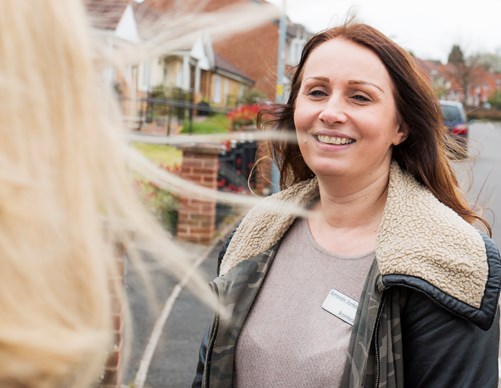
Getting connected to our communities
The content in this article may now be out of date. Please try searching for a more recent version.
You could argue Amanda Jordan was one of the main drivers behind Bromford investing £3m in its new localities programme – designed to transform frontline housing management services.
It was Amanda and fellow colleague Andrea Gilchrist who took on the (some might say) daunting challenge of piloting the multi-skilled coach role back in 2015. The trial in Amanda’s south Birmingham community and Andrea’s rural Daventry patch proved so successful that we decided to be bold by investing in this new way of working; aimed at slowly changing the relationship we have with our customers to one which is built on mutual trust.
We’re still in the process of rolling out localities to all parts of the business but June 2017 represents two years since Amanda has been working as a neighbourhood coach more proactively in her various neighbourhoods. So with that in mind, we caught up with her to find out what’s been going well, what’s changed and what hasn’t gone so well.
The interview
Amanda admits she was initially nervous about being the first point of contact for her customers.
“I was actually dreading handing my email address and personal phone number out to customers because you kind of think you’re opening a can of worms and I questioned whether it would be harder to keep on top of,” she says, frankly.
“But actually it’s made a huge difference to my working day. I was always conscious of having to make time so I could do my tasks raised through the contact centre. I typically received 15 each day and you only had a limited time to respond otherwise they’d show in the system as red.
“I don’t get any tasks now. Customers call, email or text me directly and it actually saves time and is much better for my customers as often they’ll text when I’m already at the scheme so I can respond straight away rather than picking up the message at the end of the day and realising I had been there earlier on.”
And what of the overall impact, we ask? Amanda (right) is quick to tell me that customer engagement has “massively improved”, she no longer has any cases of anti-social behaviour (compared to four on a single scheme previously), arrears have fallen, fly-tipping has been resolved and fewer of her customers are ending up in court. Almost two years in, Amanda has visited all but one road on her patch.
“I think the single biggest positive is having a presence in my neighbourhoods again. Customers get to know you as a person – you become the face of Bromford rather than being a faceless housing association – and that means customers are much more willing to work with me.
Amanda stresses it’s crucial to recruit the right colleagues as the role of neighbourhood coach isn’t for everyone. She adds that it will only be once everybody is settled in their patch for a decent length of time that any lasting changes will be truly felt. But she is passionate about what an effective way of working the neighbourhood coach role is – and how she would hate to return to the housing manager days of old.
“Customers talk to me a lot more openly now which shows the trust they have in me,” Amanda continues. “Getting to know more of your customers definitely brings benefits as I have learnt so much more about what their triggers and behaviours are. Along the way I uncovered all sorts of issues I didn’t know existed – I’d worked on this patch for seven years already but I really didn’t know my customers like I thought I did.
“And sometimes, it can present new obstacles. I recently made a major breakthrough with a lady living with multiple mental health conditions – sometimes it can be a fine line between supporting the customer versus creating dependency. I quickly learnt it’s about having a bespoke coaching approach for each situation – I can have honest conversations with my customers though and while the visits to some might start off being weekly, eventually they will become fortnightly or monthly as they build more resilience.”
It’s clear from Amanda that customers respond positively to their new relationship with her and Bromford, but that building a relationship of trust and then realising positive outcomes for customers does take time.
Find out more about why we’re changing how we do things here.